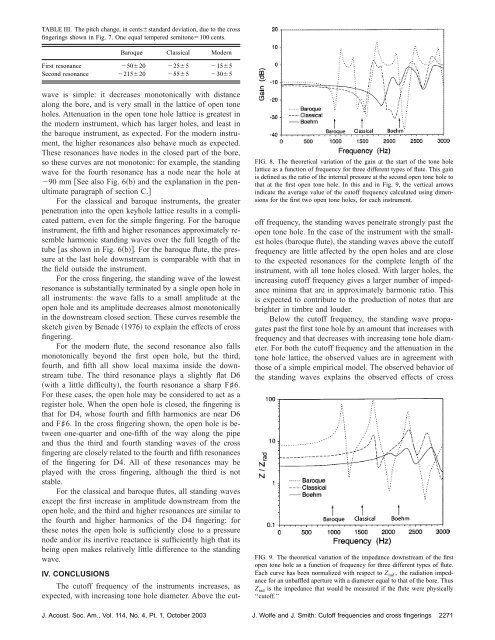Cutoff frequencies and cross fingerings in ... - School of Physics
Cutoff frequencies and cross fingerings in ... - School of Physics
Cutoff frequencies and cross fingerings in ... - School of Physics
Create successful ePaper yourself
Turn your PDF publications into a flip-book with our unique Google optimized e-Paper software.
TABLE III. The pitch change, <strong>in</strong> centsst<strong>and</strong>ard deviation, due to the <strong>cross</strong><br />
<strong>f<strong>in</strong>ger<strong>in</strong>gs</strong> shown <strong>in</strong> Fig. 7. One equal tempered semitone100 cents.<br />
Baroque Classical Modern<br />
First resonance 5020 255 155<br />
Second resonance 21520 555 305<br />
wave is simple: it decreases monotonically with distance<br />
along the bore, <strong>and</strong> is very small <strong>in</strong> the lattice <strong>of</strong> open tone<br />
holes. Attenuation <strong>in</strong> the open tone hole lattice is greatest <strong>in</strong><br />
the modern <strong>in</strong>strument, which has larger holes, <strong>and</strong> least <strong>in</strong><br />
the baroque <strong>in</strong>strument, as expected. For the modern <strong>in</strong>strument,<br />
the higher resonances also behave much as expected.<br />
These resonances have nodes <strong>in</strong> the closed part <strong>of</strong> the bore,<br />
so these curves are not monotonic: for example, the st<strong>and</strong><strong>in</strong>g<br />
wave for the fourth resonance has a node near the hole at<br />
90 mm See also Fig. 6b <strong>and</strong> the explanation <strong>in</strong> the penultimate<br />
paragraph <strong>of</strong> section C.<br />
For the classical <strong>and</strong> baroque <strong>in</strong>struments, the greater<br />
penetration <strong>in</strong>to the open keyhole lattice results <strong>in</strong> a complicated<br />
pattern, even for the simple f<strong>in</strong>ger<strong>in</strong>g. For the baroque<br />
<strong>in</strong>strument, the fifth <strong>and</strong> higher resonances approximately resemble<br />
harmonic st<strong>and</strong><strong>in</strong>g waves over the full length <strong>of</strong> the<br />
tube as shown <strong>in</strong> Fig. 6b. For the baroque flute, the pressure<br />
at the last hole downstream is comparable with that <strong>in</strong><br />
the field outside the <strong>in</strong>strument.<br />
For the <strong>cross</strong> f<strong>in</strong>ger<strong>in</strong>g, the st<strong>and</strong><strong>in</strong>g wave <strong>of</strong> the lowest<br />
resonance is substantially term<strong>in</strong>ated by a s<strong>in</strong>gle open hole <strong>in</strong><br />
all <strong>in</strong>struments: the wave falls to a small amplitude at the<br />
open hole <strong>and</strong> its amplitude decreases almost monotonically<br />
<strong>in</strong> the downstream closed section. These curves resemble the<br />
sketch given by Benade 1976 to expla<strong>in</strong> the effects <strong>of</strong> <strong>cross</strong><br />
f<strong>in</strong>ger<strong>in</strong>g.<br />
For the modern flute, the second resonance also falls<br />
monotonically beyond the first open hole, but the third,<br />
fourth, <strong>and</strong> fifth all show local maxima <strong>in</strong>side the downstream<br />
tube. The third resonance plays a slightly flat D6<br />
with a little difficulty, the fourth resonance a sharp F♯6.<br />
For these cases, the open hole may be considered to act as a<br />
register hole. When the open hole is closed, the f<strong>in</strong>ger<strong>in</strong>g is<br />
that for D4, whose fourth <strong>and</strong> fifth harmonics are near D6<br />
<strong>and</strong> F♯6. In the <strong>cross</strong> f<strong>in</strong>ger<strong>in</strong>g shown, the open hole is between<br />
one-quarter <strong>and</strong> one-fifth <strong>of</strong> the way along the pipe<br />
<strong>and</strong> thus the third <strong>and</strong> fourth st<strong>and</strong><strong>in</strong>g waves <strong>of</strong> the <strong>cross</strong><br />
f<strong>in</strong>ger<strong>in</strong>g are closely related to the fourth <strong>and</strong> fifth resonances<br />
<strong>of</strong> the f<strong>in</strong>ger<strong>in</strong>g for D4. All <strong>of</strong> these resonances may be<br />
played with the <strong>cross</strong> f<strong>in</strong>ger<strong>in</strong>g, although the third is not<br />
stable.<br />
For the classical <strong>and</strong> baroque flutes, all st<strong>and</strong><strong>in</strong>g waves<br />
except the first <strong>in</strong>crease <strong>in</strong> amplitude downstream from the<br />
open hole, <strong>and</strong> the third <strong>and</strong> higher resonances are similar to<br />
the fourth <strong>and</strong> higher harmonics <strong>of</strong> the D4 f<strong>in</strong>ger<strong>in</strong>g: for<br />
these notes the open hole is sufficiently close to a pressure<br />
node <strong>and</strong>/or its <strong>in</strong>ertive reactance is sufficiently high that its<br />
be<strong>in</strong>g open makes relatively little difference to the st<strong>and</strong><strong>in</strong>g<br />
wave.<br />
FIG. 8. The theoretical variation <strong>of</strong> the ga<strong>in</strong> at the start <strong>of</strong> the tone hole<br />
lattice as a function <strong>of</strong> frequency for three different types <strong>of</strong> flute. This ga<strong>in</strong><br />
is def<strong>in</strong>ed as the ratio <strong>of</strong> the <strong>in</strong>ternal pressure at the second open tone hole to<br />
that at the first open tone hole. In this <strong>and</strong> <strong>in</strong> Fig. 9, the vertical arrows<br />
<strong>in</strong>dicate the average value <strong>of</strong> the cut<strong>of</strong>f frequency calculated us<strong>in</strong>g dimensions<br />
for the first two open tone holes, for each <strong>in</strong>strument.<br />
IV. CONCLUSIONS<br />
The cut<strong>of</strong>f frequency <strong>of</strong> the <strong>in</strong>struments <strong>in</strong>creases, as<br />
expected, with <strong>in</strong>creas<strong>in</strong>g tone hole diameter. Above the cut<strong>of</strong>f<br />
frequency, the st<strong>and</strong><strong>in</strong>g waves penetrate strongly past the<br />
open tone hole. In the case <strong>of</strong> the <strong>in</strong>strument with the smallest<br />
holes baroque flute, the st<strong>and</strong><strong>in</strong>g waves above the cut<strong>of</strong>f<br />
frequency are little affected by the open holes <strong>and</strong> are close<br />
to the expected resonances for the complete length <strong>of</strong> the<br />
<strong>in</strong>strument, with all tone holes closed. With larger holes, the<br />
<strong>in</strong>creas<strong>in</strong>g cut<strong>of</strong>f frequency gives a larger number <strong>of</strong> impedance<br />
m<strong>in</strong>ima that are <strong>in</strong> approximately harmonic ratio. This<br />
is expected to contribute to the production <strong>of</strong> notes that are<br />
brighter <strong>in</strong> timbre <strong>and</strong> louder.<br />
Below the cut<strong>of</strong>f frequency, the st<strong>and</strong><strong>in</strong>g wave propagates<br />
past the first tone hole by an amount that <strong>in</strong>creases with<br />
frequency <strong>and</strong> that decreases with <strong>in</strong>creas<strong>in</strong>g tone hole diameter.<br />
For both the cut<strong>of</strong>f frequency <strong>and</strong> the attenuation <strong>in</strong> the<br />
tone hole lattice, the observed values are <strong>in</strong> agreement with<br />
those <strong>of</strong> a simple empirical model. The observed behavior <strong>of</strong><br />
the st<strong>and</strong><strong>in</strong>g waves expla<strong>in</strong>s the observed effects <strong>of</strong> <strong>cross</strong><br />
FIG. 9. The theoretical variation <strong>of</strong> the impedance downstream <strong>of</strong> the first<br />
open tone hole as a function <strong>of</strong> frequency for three different types <strong>of</strong> flute.<br />
Each curve has been normalized with respect to Z rad , the radiation impedance<br />
for an unbaffled aperture with a diameter equal to that <strong>of</strong> the bore. Thus<br />
Z rad is the impedance that would be measured if the flute were physically<br />
‘‘cut<strong>of</strong>f.’’<br />
J. Acoust. Soc. Am., Vol. 114, No. 4, Pt. 1, October 2003 J. Wolfe <strong>and</strong> J. Smith: <strong>Cut<strong>of</strong>f</strong> <strong>frequencies</strong> <strong>and</strong> <strong>cross</strong> <strong>f<strong>in</strong>ger<strong>in</strong>gs</strong><br />
2271
















